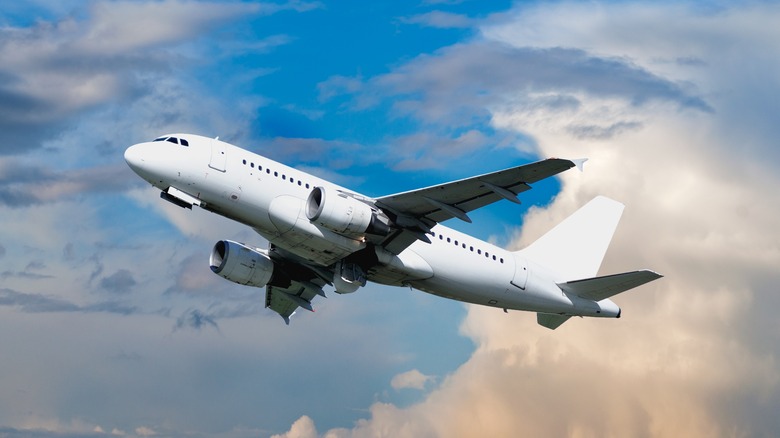Look Up Any Plane You See With This Easy Tail Trick
We may receive a commission on purchases made from links.
You won't likely find an airline pilot shuffling through the line at the aviation equivalent of a registry of motor vehicles to plates for a plane, but every single civil aircraft in the entire world is registered under a unique code. Similar to an automobile registration or a social security number, an aircraft tail number is a one-of-a-kind identifier that links to a bounty of background information. There's more to that code than meets the eye. It's a veritable treasure trove of data hidden in plain sight — and you don't need a secret decoder ring to figure it out.
The next time you're seated on a plane waiting to push back, take a look through the window at the aircraft parked at the adjacent gate. The tail number is the string of letters and numbers painted toward the end of the fuselage. It references a specific file contained in an international database that tracks a worldwide fleet of almost 30,000 aircraft. Data on file includes country of origin, ownership history, and maintenance records. Some numbers even give a coded shoutout specific to the airline or the specific aircraft. Let's start at the beginning. The first letter in the tail code identifies the plane's country of origin. If the alphanumeric series starts with the letter N, you're looking at a plane from the United States. Aircraft codes for planes registered in Canada start with the letter C. British aircraft tail numbers begin with the letter G.
Are you beginning to see a pattern? That's a trick question. We didn't either and we only became more confused when we learned tail numbers for planes from India start with VT and planes from Greece are marked with code that begins with SX.
Here's how to decode the code
Turns out the letters that signify country of origin are based on radio call signs assigned to countries by the International Telecommunications Union. What's the connection? The best we can figure is the call signs already existed, so it made sense to use them as opposed to creating a whole new list aviation-specific country codes.
In its simplest form, an aircraft registration code plays out like this. After country of origin, the sequence of letters and numbers and what they signify can vary by country. In the United States, individual airlines choose the next three characters, often creating an internal code to group planes in its fleet by aircraft make and model. The last two characters reference the airline code of the current operator — DL for Delta, UA for United, and so on. But that's not the end of the story. Just like cars, aircraft can cycle through multiple owners during their lifetimes. And sometimes airlines merge, pushing the meaning of the tail number into murky territory as carriers attempt to create an identifiable trail of ownership.
Here's what American Airlines did to honor the US Airways legacy when the companies merged in 2013. Aircraft owned by American Airlines prior to the merger or delivered after the companies were combined bear the markings AA, AN, or NN. Codes that end in UW, US, or AY indicate the aircraft previously flew under the US Airways banner. And if you see a tail number that starts with AW on an American Airlines aircraft, that means the plane was part of the America West Airlines fleet prior to its 2005 merger with US Airways. That's a lot of information hidden in plain sight, and it's just the tip of the iceberg.
Information is hidden in plain sight
On occasion, commercial carriers come up with tail numbers to honor specific individuals or landmark moments in the airlines' history. Southwest Airlines' fleet includes a Boeing 737 MAX 8 bearing the tail number N871HK. The HK stands for Herb Kelleher who founded the airline in 1966 and is widely credited with making air travel affordable to middle-class Americans. And if you catch a glimpse of Southwest's Freedom One, a Boeing 737-800 with the tail number N500WR, you're looking at a plane dedicated to Boeing's William Rogers in honor of the role he played in the delivery of the carrier's 500th aircraft.
Remember Jack Sweeney, the Florida teen who drew international attention when he began tracking and posting the locations of private jets belonging to controversial billionaire Elon Musk and pop star Taylor Swift? Did you wonder how he figured out which planes, out of all the aircraft in the sky at any given time, belonged to the celebrities? Owners of private planes often come up with an alphanumeric code that has special significance to them. It's kind of like the aviation industry's equivalent of a vanity license plate. The numbers are easy to decode once you know where to look. Take, for example, the tail number on Swift's private jet. The code, N898TS, shows the U.S. as the country of origin and includes Swift's year of birth and initials.
Have we piqued your interest? It's easy to get started. The Federal Aviation Administration updates its Aircraft Registration Database daily — and it's available to the general public. Additionally, flight-tracking apps like Flightradar24 and FlightAware have a function, usually available with a paid subscription, that lets users research specific aircraft by tail number and even receive notifications regarding the plane's real-time location.


